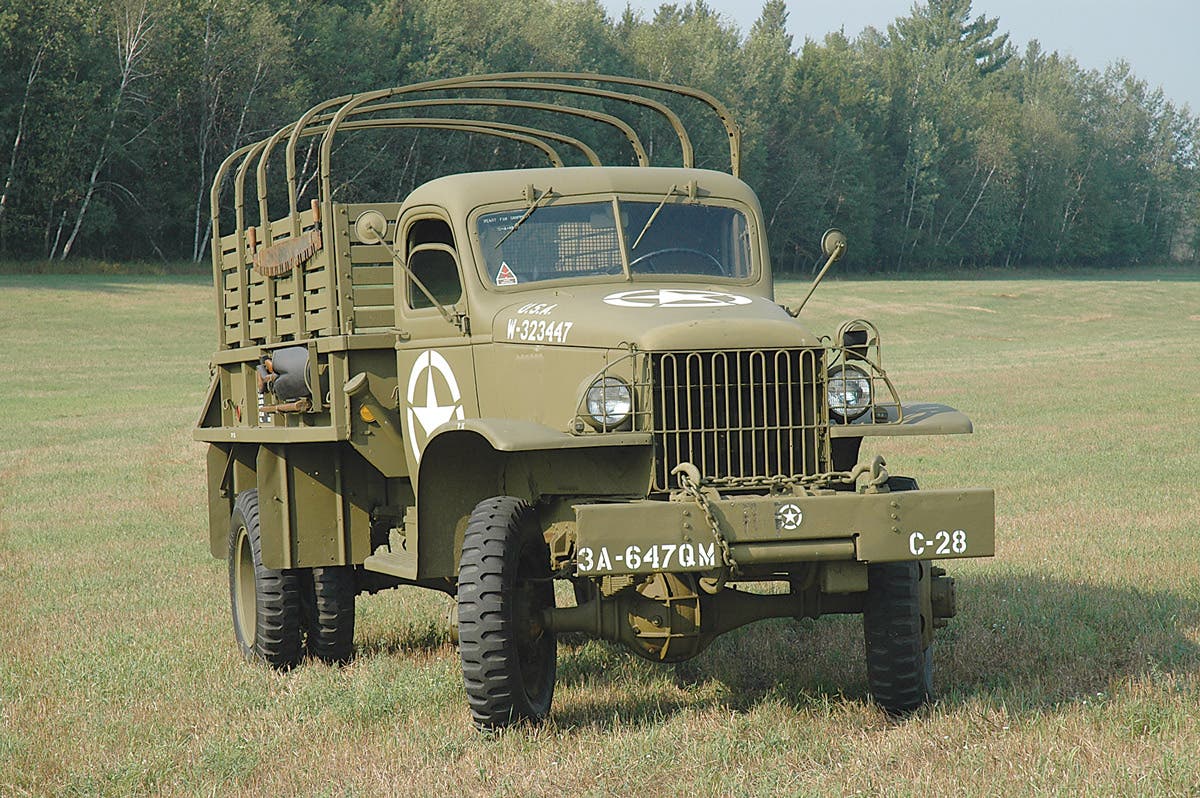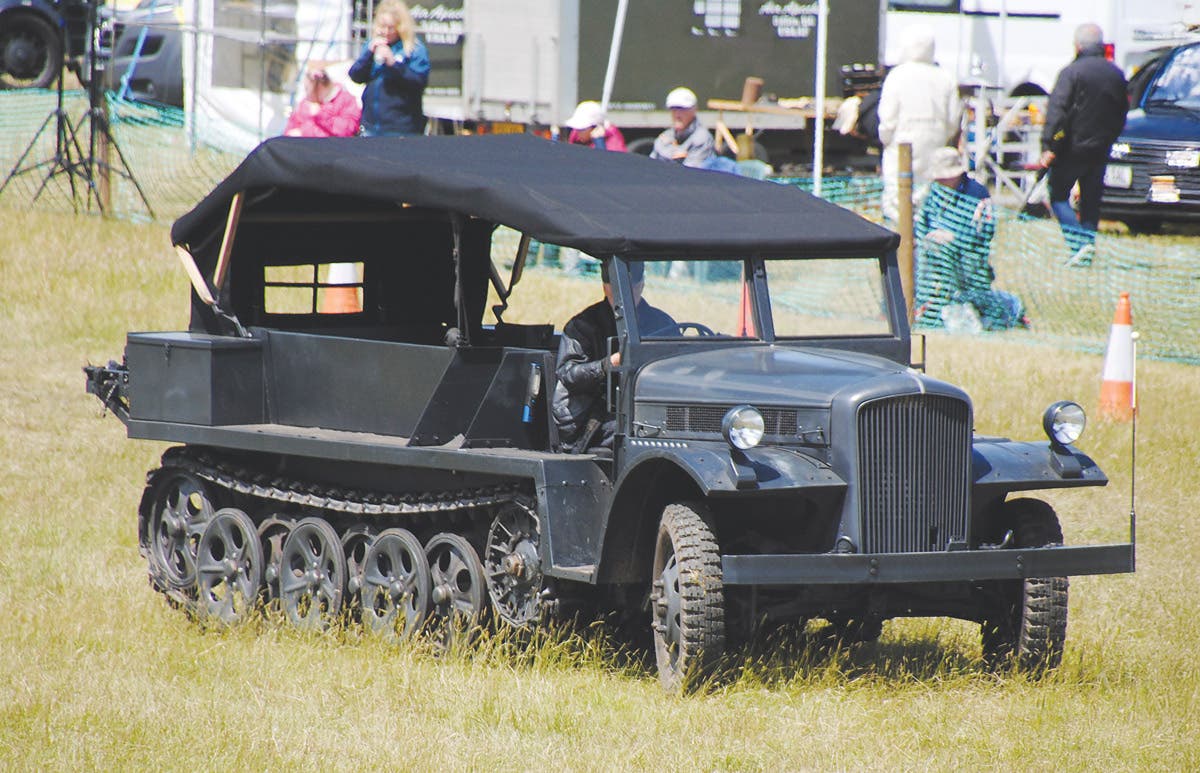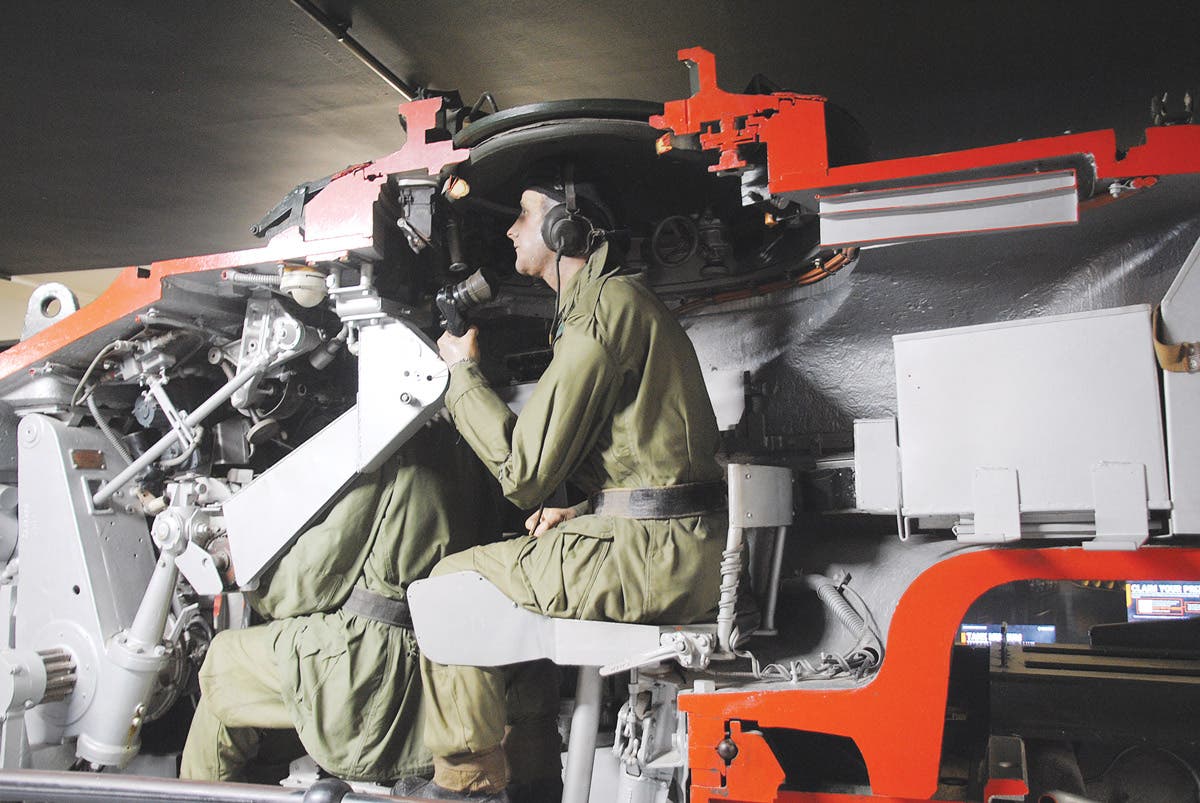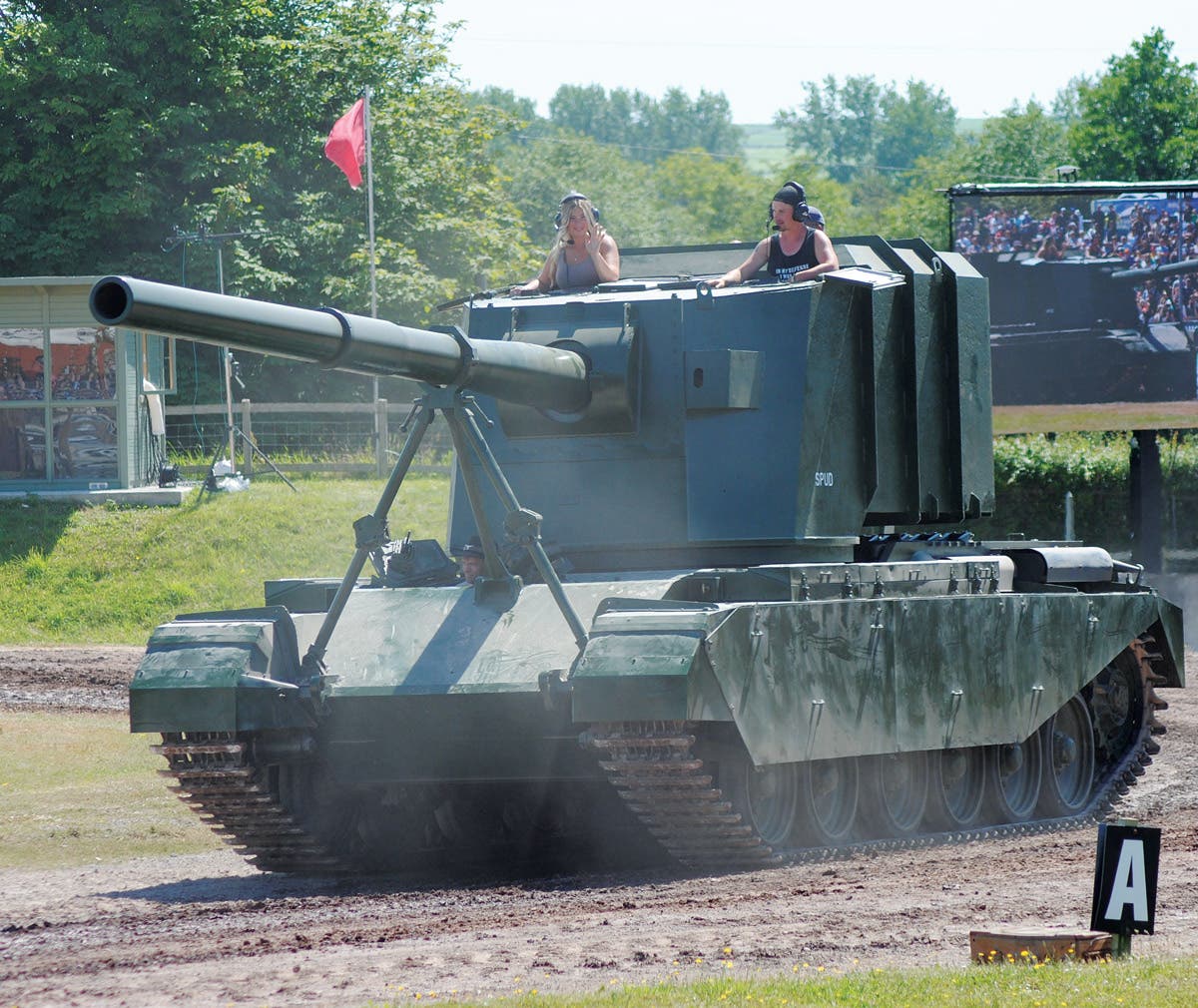MV Garage: It’s time to spring ahead!
by Steve Turchet No matter how strong a military vehicle’s springs may have been when they first left the factory, and no matter how light a load a vehicle may…
by Steve Turchet
No matter how strong a military vehicle’s springs may have been when they first left the factory, and no matter how light a load a vehicle may have carried in past lives, thirty, fifty, or seventy years of just sitting idle or merely toting itself around have probably flattened and weakened them. In this article, we’re going to examine some ways to restore the arch (or arc) and strength to a vehicle’s leaf springs, and/or to raise it back up to its original body height. We will also discuss coil springs, as used on MUTTs, many CUCVs, and HMMWVs.
HARD OR SOFT RIDE
The basic design of vehicle leaf springs hasn’t changed much in over a century; and until around the 1950s the general rule for truck springs was to make them stiff and massive. I’ve driven a few old trucks with a spring-rate so stiff that it always surprised me that their cabs weren’t shaken to pieces. For heavy, long-distance, over-the-road trucks, driver comfort was usually provided by shock-absorber, spring, or air-cushioned seats rather than soft suspension systems.
On the other hand, for automobiles of the late 1940s up into the mid 1960s, “mushy” seemed to be the most sought-after quality in springs. This was probably because most U.S. highways were paved by that time, so cars didn’t have to contend with dirt roads and ruts anymore.
You may also wonder if a soft ride was Detroit’s way of enticing the generation who had won WWII into buying new cars. Many of that generation had painful memories of hard wooden benches in the back of CCKWs.
Some readers may remember that era, when every new car model was “longer, lower, and wider” than the previous year’s model. It was a time when people sat on a seat like a living room sofa aboard a Cris-Craft plowing through quicksand and wallowed around every corner like a drunken hippopotamus (often to the shriek of bias tires!).
Coil springs were used on many American cars of that time, as well as the new Ford-designed MUTT.Some experimentation with light and medium-duty civilian trucks also occurred, with varying degrees of success. For example, early 1960s Chevrolet pickups had a nervous and floaty coil spring and trailing-arm rear suspension.
Front torsion-bars were also tried on light and medium civilian trucks – many early to mid-1960s GMC trucks had them. Meanwhile, Ford touted its “Twin I-beam” and coil front suspensions. This latter system caused what was known as the “Bronco bounce” among 4x4 fans in those days.
Many of today’s truck manufacturers have returned to leaf spring suspensions. For one thing, they’re the simplest form of suspension system. For another, they’re also the cheapest. Since most common collectable U.S. Military vehicles have leaf springs on both the front and rear, we’re going to cover them first.
LEAF SPRINGS
As a general rule, the more leaves there are in a spring assembly the better a vehicle’s ride is going to be. Also, the more leaves, the more versatile the spring. This means that more leaves will usually give a better ride under all operating conditions.
Of course, more leaves cost more, so it’s not surprising that truck manufacturers – especially on pickups – began to see how few they could get away with. For example, the all-time worst ride I ever experienced in any vehicle (except a Caterpillar tractor) was in a 1977 Chevy Silverado 3/4-ton 4x4 pickup. There were, if I recall, only two stiff leaves in its front spring assembly. On a concrete freeway, the truck’s ride could have been politely described as “choppy,” while off-road, the truck tried to put my head through the cab roof each time I crossed a desert wash or hit a chuckhole.
By comparison, the M37 I had at the time rode like a vintage Cadillac! This was because an M37 has a lot of leaves of varying lengths in its spring assemblies.
It isn’t hard to understand how a leaf spring assembly works, and it’s relatively easy to engineer your own vehicle’s spring-rates by “field-repair” methods, though the actual arch of the springs – how high a vehicle sits above its axles – usually requires professional help.
Most cargo trailers have very short leaves because ride isn’t a big concern. In the case of that bizarrely-sprung Silverado – which did have long leaves – the problem was that there weren’t enough leaves. In other words, two heavy leaves, no matter how long, can’t be as versatile as five or six lighter ones.
Cargo vehicles present the biggest challenge when it comes to spring design, because a truck must be able to comfortably carry its rated load – so its springs must be stiff – yet it shouldn’t ride like a brick on a skateboard when empty. For most smaller MVs such as Jeeps or Dodge WCs and M37s, a compromise was made... and for these vehicles, it was usually made very well.
One exception to well-engineered springs on common U.S. MVs is the Kaiser M715. This was a civilian pickup (the Jeep Gladiator) adapted from a 3/4-ton design into a 1-1/4-ton military truck. This was accomplished mainly by giving it heavier springs. However, the leaves were so stiff that the truck often got stuck in twisted situations where the right front and left rear wheels (or vice-versa) lost contact with the ground because the springs didn’t have enough flex. This is another example of how a compromise must be made, especially on a military vehicle: Make the springs stiff enough to carry heavy loads and they may be too stiff to sufficiently flex over rough terrain.
A versatile leaf spring assembly usually has a lot of leaves. The long leaves give the best ride when a vehicle is empty, while the shorter leaves take more of the weight, making the assembly stiffer when the vehicle is loaded. This is called a progressive spring assembly, meaning that it adjusts to its load. Most modern coil springs, such as those used on MUTTs, HMMVWs, and CUCVs are also progressive. This is usually accomplished by making the coils wider apart in the middle of the spring and closer together at one or both ends. In a no-load highway situation, most of the flex is in the middle of the coil, which gives a softer ride. When the vehicle is loaded, the middle compresses, making the whole coil shorter and stiffer.
Still, even the most well-designed springs are a compromise on cargo vehicles, because a single assembly can’t provide the most desirable ride under all conditions and loads. Therefore, larger trucks usually have what are commonly called “overload springs,” but which should properly be called secondary springs. This is because they are not for overloading beyond the vehicle’s rated capacity, but instead are intended to take over part of the load by making contact with their pads as the vehicle is weighed down. This allows the main spring assembly to be built lighter and with more flex to give the vehicle a better ride when empty It is the same concept as making a coil spring wider in the middle.
Tandem-axle-drive trucks such as deuce-and-a-halfs, can have heavier and stiffer rear spring assemblies due to the fact that twin axles provide a lot of flex by being able to move independently. And, there isn’t much you can – or should –do to try beef up or modify these.
It’s a rare deuce that has been used so heavily that its rear springs are actually worn out... with the exception of tippers, tankers, and sometimes shop trucks. If the springs on such vehicles are worn out, then replacing them with NOS or good used assemblies is usually the simplest, cheapest, and best option.
REPAIR, REPLACE, OR BEEF-UP
Since Jeeps, WCs, M37s, and deuce-and-a-halfs with leaf springs are the most common U.S. historic MVs in the hobby, let’s talk about repairing, replacing, or beefing up their springs. Even M715 owners might benefit from some of this advice, though there isn’t really a simple quick-fix for your five-quarter’s starchy suspension. To vastly improve an M715’s ride, you will probably have to replace all the springs with custom-designed assemblies. But, if it makes you feel any better, the stock springs usually don’t sag that much.
But, again, the springs of all vehicles, no matter how well-treated, will eventually weaken and sag with time. It’s the same reason why fishing rods or boat oars should never be hung horizontally. There are many factors in how badly or quickly leaf springs will weaken. Naturally, a lot depends upon how and where the vehicle is used; but how strong the springs were to begin with is another important factor. This has a lot to do with the quality of steel from which they were made.
For example, early model Toyota Land Cruisers and Nissan Patrols (which are / were MVs in some parts of the world) have what look like very beefy springs. The steel, however, was apparently not very good, and they weakened and flattened within a few years, no matter how well the vehicles were treated.
“Simple” is a relative term when it comes to vehicle modifications or repairs: we speak of “dropping in engines” or “pulling transmissions” either from experience – or lack of same – which often confuses the middle-ground mechanic or do-it-yourself HMV owner when he or she finds that “dropping in an engine” is really not simple. So, too, we often hear casual references about “re-arching” (or “arcing”) leaf springs as the best and simplest way to solve a sagging problem, though we may not fully understand what’s actually involved.
Re-arching is probably the best way to restore a vehicle’s height and ride, but for many people the thought of removing all four spring assemblies – which means jacking, blocking, and removing the axles, as well as (usually) fighting rusted nuts and bolts – seems anything but simple! It is also what you would have to go through if replacing a vehicle’s sagging springs with NOS or good used assemblies, however.
Once the springs are out of the vehicle, take them to a shop where (hopefully) skilled and experienced people heat and bend them back into (hopefully) their original arch and strength. If done correctly, these rebuilt assembles are often better than NOS, because, unlike mass-produced factory springs, they are (again, hopefully) given careful attention. Neither fix is cheap, though for some HMVs, NOS or good, used springs may cost a lot less than having the old ones rebuilt.
As most veterans know, there are usually three ways of doing things: The right way, the wrong way, and the “Army way.” There is also a fourth way: “The field-repair way.” In the case of vehicle springs, the field-repair way probably isn’t as good as having them rebuilt or installing NOS or good, used assemblies, but it’s definitely cheaper. However, it still involves all the work (and more) of the other three ways.
If you don’t use your HMV for actual work, much off-roading, or cargo-carrying, then about the only reason to fix flattened springs would be for the sake of appearance –to restore its original stance and height and / or to bring back its factory ride. If you are restoring an HMV for show, then it’s usually better to have the old springs rebuilt or replace them with NOS or good, used assemblies, rather than to do any “field-repairs.”
On the other hand, if you only want a macho-looking vehicle that sits up high on its axles, you might not care about how they lift it, or how it rides afterward! The bargain-basement way of raising a vehicle’s body is with longer spring shackles... like a lot of kids used to do with their first suicide-machines. This is the wrong way for many reasons, some of which were discussed in past articles dealing with front-end shimmy and axle alignment. I did it once when I was a kid on a ‘64 International Scout; and though I don’t know for sure if that was the reason, the Scout broke two spring leaves shortly afterward.
Another cheap way to raise a vehicle is by installing lifting block kits, which are usually available at auto-mart stores and 4x4 accessory shops. While this method is mechanically better than using long shackles, it can also mess up the front-end alignment, resulting in annoying or dangerous handling characteristics. Improper use of lifting blocks can also mis-align a rear axle, putting the U-joints out of sync and causing their premature failure. Furthermore, either longer shackles nor lifting block kits can strengthen or restore a sagging spring system. All they do is raise the body a little higher above the problem.
Yet another quick-fix is installing coil helper springs, which bolt onto a vehicle’s axles between the axle and frame. Like longer shackles and lifting blocks, these helper spring kits can usually be found at auto-mart stores, as well as from many on-line sources. If chosen with care as to weight-capacity and properly installed, such kits can make a big difference in vehicle height. They will strengthen – though can’t repair – a weak or sagging spring system.
One company offers such kits in 1,000-, 1,500-, and 2,000-pound capacities... though their estimates seem a bit optimistic. I have a set of these on the rear axle of my 1965 Nissan Patrol, even though I “field-repaired” the flattened leaf springs to restore original body height. The coil kit now only functions when toting a lot of weight.
Such kits can usually be installed in about an hour on Jeeps, WCs, and M37s, but pay careful attention to brake lines and tire clearance. Also be sure to check their mounting clamps for tightness now and again. They tend to work loose. Even for a Jeep, I’d suggest using a “1,500” pound kit. Since these helper springs are generally out of casual sight when installed, they don’t detract much from a vehicle’s stock appearance.
The downside of using these kits is that if the coil springs are strong enough to raise body height, then they are basically replacing a vehicle’s individually-designed leaf spring suspension with one-size-fits-all coils. The result will be a vehicle ride that is nervous and bouncy... though new shock-absorbers may help.
You may also see “Add-A-Leaf kits” when browsing an auto-mart store or on-line. I have tried them and I don’t like them. These kits seem marginal at actually raising a flattened spring system, though they can prevent it from sagging more. Many such kits require unbolting the axle from the springs to install. If you aregoing to go to all that trouble, then why not fix the problem by installing NOS or good used springs or having the old ones rebuilt?
Most of these kits are visible when installed and may detract from the appearance of a vintage HMV. This seems to leave you with four good choices (forget the two bad ones) of how to raise a vehicle and strengthen its suspension system:
1) Replace the old springs with NOS or good used assemblies. (Applies to leaf springs as well as coils.)
2) Have the old springs rebuilt. (Also applies to leaf springs and coils.)
3) Install coil helper-springs on leaf-spring suspensions.
4) field repair a leaf spring suspension.
FIELD REPAIR
As mentioned earlier, the field repair way may not seem simple to some home mechanics. It involves the same jacking, blocking, axle-dropping, and fighting rusted bolts and fittings as replacing old springs with new ones or having the old springs rebuilt. In fact, it involves more work and time then doing the first two fixes, and much more than doing the third. It does, however, have two advantages: It’s a lot cheaper than doing the first two, and does a much better job than the third.
Nevertheless, it’s usually not a good option for restoring a vehicle. Even if you may not care about restoring your HMV at the moment, you may want to restore it someday. If so, you would have to replace your springs all over again.
As I’ve mentioned in previous pieces, my “HMV” is a 1965 Nissan Patrol L60, though there is very little about it that’s Nissan anymore, except the body, frame, and axles. I replaced the original in-line six-cylinder engine with a 304 IHC V-8. This is a dedicated truck engine and very heavy for its size. It was far too much weight for the already weak and sagging front springs, but for reasons involving time and money I wasn’t able to fix the problem correctly, or even do a good field-repair.
Instead, I made do with coil helper springs for several years. At last, I briefly found myself with some extra time and a bit of money. I went to a spring shop to check out the cost of having the Nissan assemblies rebuilt and adding extra leaves. However, I wasn’t about to pay $250 per spring assembly!
Instead, I drove to a truck wrecking yard. After taking measurements of the Patrol’s spring leaves, I searched among the rusting corpses until I found a stout set of rear springs on a 1970s Ford 1-1/2 ton truck with leaves of about the same length and width as the Nissan’s – but heavier. These springs still had a nice arch even with two other trucks stacked on the Ford’s frame.
Since I wasn’t going to use the Ford’s top leaves (the Patrol’s top leaves were kept to attach to the spring hangers and shackles),it was a simple matter to have the Ford assemblies torched off. So, within half an hour – and for only $80– I had enough sturdy and well-arched leaves to rebuild my Patrol’s entire system, front and rear.
I’m assuming that if you feel up to this job, you also know what’sinvolved in removing and remounting a vehicle’s springs. Besides the obvious – jacks, and adequate blocks or stands, you need a good, basic tool set. About the only special tools needed are a pair of heavy C-clamps.
If you plan to add more leaves to your vehicle’s assemblies, you should measure to see if your present axle U-bolts are long enough to compensate for the extra thickness. The nuts should always be fully threaded onto the bolts. If not, you will have to get new U-bolts (available at most auto parts and 4X4 stores, or on-line).
It should go without saying that you’ll have to jack up and block your vehicle by its frame, unbolt the axles from the springs – taking care of steering linkages, shock-absorbers, and brake lines – then, unbolt the spring assemblies from their hangers and shackles. On most common HMVs, the leaves are held together as a unit by a single center bolt, and there are usually two – sometimes four – rebound clips. The purpose of the clips is to keep the leaves aligned fore and aft, and to prevent the spring assemblies from opening up like an accordion then slapping back together when the vehicle bounces. Some of these rebound clips use a bolt, while others are bent into place. They are usually also riveted to a spring leaf to keep them in position.
How you go about dealing with them will depend upon your own vehicle and whether or not you’re adding extra leaves. You can usually unbend to remove, reshape, and then re-bend the clips at least once without breaking them cold, but having a torch to heat them makes for better blacksmithing.
The rivets can be removed with a hammer and chisel and/or grinder. Rivets are still available at many hardware stores. Grade-2 bolts can make satisfactory substitutes for rivets; and with a little imagination and drilling you can reinstall the clips on your “new” spring assemblies just as if they came from the factory that way.
Although the center bolt often has a cylindrical head for locating the axle pad onto the springs, it is otherwise usually just a 5/16” or 3/8” SAE-thread Grade-8 bolt. Many times, you’ll find its nut is hopelessly rusted on, and the bolt will break when you try to remove it. It’s probably a good idea to replace the bolt anyway. If you’re adding extra leaves, then, of course, the replacement bolts will have to be longer than the originals. You can buy these special bolts at most spring shops or on-line, but a little grinder or file work will adapt the heads of ordinary Grade-8 bolts to fit the locating holes in the axle pads. Use Grade-8 nuts.
Be careful when removing these bolts from the spring assemblies. The leaves may fly apart when the nut is removed, or if the bolt should break. Also, be careful if you get the nut off but the bolt is rusted in place, because it may let go suddenly and scatter spring leaves all over you.
BUILDING A NEW ASSEMBLY
Building your new spring assemblies is simply a matter of stacking leaves. Your old top leaf is probably flat and won’t willingly conform to the arch of the new lower leaves. It will when the springs are re-installed, and vehicle’s weight comes onto it.
For now, you’ll probably need two C-clamps to draw all the leaves together while installing the center bolt. Keep in mind that the spring leaves want to fly apart and can hurt you if they do. Use a little grease or anti-seize compound on the bolt.
When building your assemblies, remember that the more leaves you add, the stiffer your vehicle’s ride will be. More leaves (well-arched of course) will also raise your vehicle’s body height: but one or two strong and well-arched leaves will make a big difference in both stiffness of ride and body height.
Don’t build a suspension system that takes out your teeth when hitting a bump. Also remember that if you’re raising the original factory height of your vehicle over about three inches, you’ll probably need longer shock absorbers and flexible brake lines.
Once the springs are reassembled, the installation process is just the reverse of removal. Use plenty of grease on the shackles and hangers. Lube them again with a grease gun after everything is back together. Tighten the axle U-bolts securely.
Now is a good time to replace worn bushings or install new shock absorbers. Be sure to recheck the tightness of the U-bolts, spring shackles, hangers, shock absorbers, and rebound clips after a few miles of driving, and at frequent intervals afterward until all the parts settle into place.
You will probably be pleased by your vehicle’s new higher stance. Whether or not you’re happy with its new ride remains to be felt... hopefully you haven’t turned your M37 into an M715!








